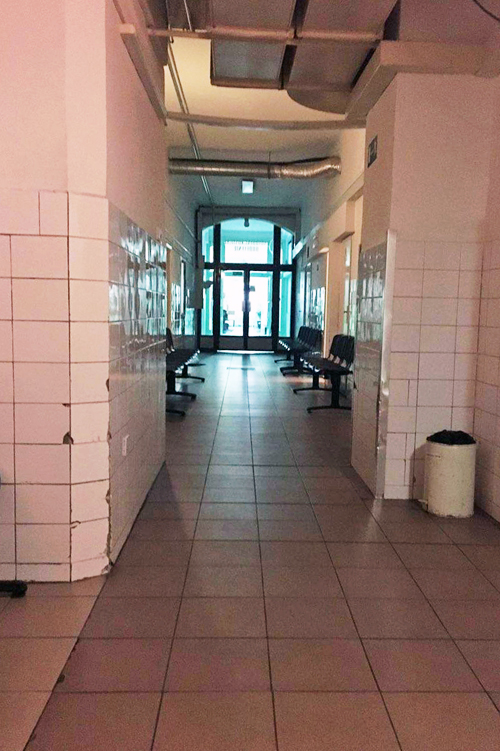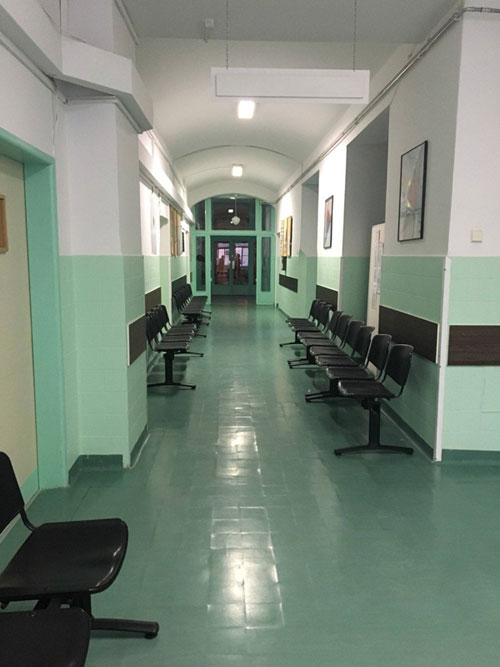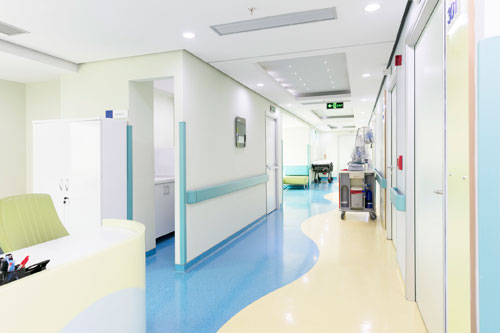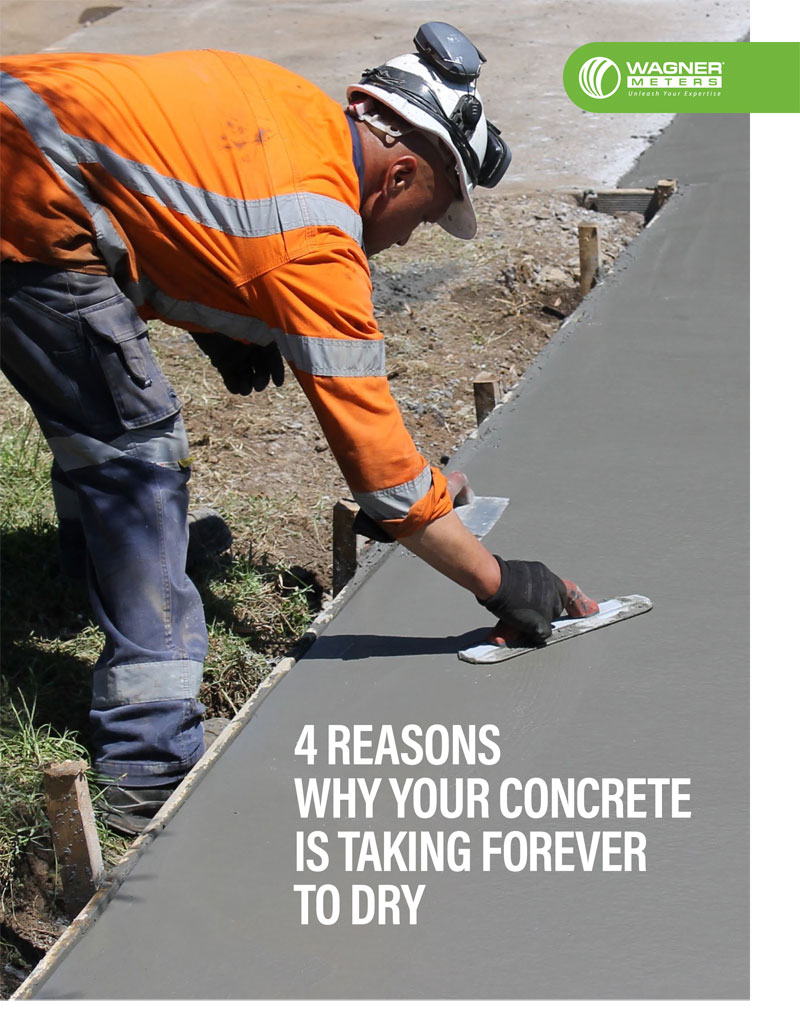How to Prevent Costly Flooring Failures That Cause Adverse Health Environments In Healthcare Facilities
As Seen In Floor Trends Magazine
In past years, many healthcare facilities overlooked the importance of flooring when considering patient safety and wellness. Hospitals, for instance, commonly used carpeting or flooring with seams between individual tiles. The seams between the tiles as well as the carpeting became magnets for mold, mildew, bacteria and other contaminants, making them unsanitary and unsafe for patients. Keeping such floors truly clean and sterile became almost impossible.

The seams between the tiles as well as the carpeting can be catch pockets for mold, mildew, bacteria, and other contaminants to accumulate, making them unsanitary and unsafe for patients.
Another commonly recurring flooring problem that was and is still often overlooked or neglected is excessive moisture that causes damp or moldy indoor environments. Aside from a possible plumbing leak or natural disaster, a more common and less obvious source of moisture is the water vapor that emits from the concrete slab beneath the flooring. All concrete slabs – both new and existing – contain moisture. When moisture comes to the surface of the slab it will interact with flooring materials and the environment. The result? De-bonded sheet flooring, bubbling, adhesive degradation, delamination, cupping, gaps between tiles, and damp, moldy conditions that could adversely affect patient and staff health.
Howard Kanare, an authority on concrete-moisture-related problems and author of Concrete Floors and Moisture writes, “Excessive moisture trapped under floor finishes can create conditions for mold and mildew to grow. When flooring is removed, blooms of fungal spores can become airborne, and may cause allergic reactions or respiratory problems.”

It’s estimated that commercial property owners spend $2.4 billion annually on remediation of structures and floor coverings due to moisture-related failures.
Upon request of the U.S. Centers for Disease Control and Prevention, the Institute of Medicine of the National Academy of Sciences assembled a committee to review the scientific literature concerning the relationship between damp or moldy indoor environments and adverse health effects. They found epidemiologic evidence that damp indoor environments caused adverse health effects, including upper respiratory symptoms, coughing, wheezing, and asthma symptoms in sensitized persons with asthma. There was also suggestive evidence that exposure to damp indoor environments also caused shortness of breath, lower respiratory illness in healthy children, and asthma development.
After the publication of the committee’s report, a study by Lawrence Berkeley National Laboratory concluded that damp and moldy buildings raised the risk of a variety of respiratory and asthma-related health effects by 30 to 50 percent. In fact, many immune-compromised individuals, such as hospital patients, are at increased risk for fungal colonization and infections. Not surprisingly, the HAI Prevalence Survey of 2014 reported an estimated 722,000 patients suffered healthcare-associated infections (HAIs) in 2011, including 75,000 patients who died from HAIs. In a 2015 HAI survey, the Centers for Disease Control and Prevention estimated that on any given day 1 in 31 hospital patients across the U.S. had an HAI.
Besides jeopardizing patient health, excessive moisture in a hospital setting is also costly. Berkeley Lab estimates the annual asthma-related medical costs attributed to exposures to dampness and mold at $3.5 billion in the U.S. Other adverse health effects due to damp, moldy environments push that cost even higher.
Damages to flooring and building materials also have a hefty price tag. It’s estimated that commercial property owners spend $2.4 billion annually on remediation of structures and floor coverings due to moisture-related failures. They also spend $1.2 billion on unplanned topical moisture treatments applied before floor coverings are installed. And, since they’re open 24 hours a day, hospitals lose revenue when they have to shut down rooms or disrupt patient care to replace damaged flooring.
New Types of Flooring

Patient rooms or the intensive care unit typically requires flooring that’s different from what is used in lobbies and corridors.
The trend among hospitals today is to select flooring that not only meets higher standards for safety, comfort, durability, acoustics, mobility, maintenance, aesthetics, and cost, but also are easier to maintain, clean, and disinfect so as to not promote the growth of mold, bacteria, and other harmful pathogens.
When it comes to choosing the best hospital flooring, many designers consider the areas to be floored. For example, patient rooms or the intensive care unit typically requires flooring that’s different from what’s used in lobbies and corridors.
Ideally, the flooring should be slip-resistant and made of nontoxic renewable materials, which is why many designers have begun to consider using natural materials like bamboo, cork, and rubber.
In hard to clean areas that are a breeding ground for biohazardous contamination, both rubber and vinyl sheet goods are used with great success. They come in 6-foot wide material requiring minimal seams. Sheet vinyl can be flash coved (as well as rubber) and both are easy to clean and maintain and are excellent for repelling microorganisms on their surface.
In operating rooms or emergency areas – where infections from exposure to open wounds and surgical cuts must be kept to a minimum – seamless floors or heat welded floors are often used.
Linoleum also has reputable antimicrobial properties to protect against germs.
Another type of sustainable flooring is polished concrete. It’s known for its durability and chemical resistance, won’t release volatile organic compounds (VOCs) into the atmosphere, and as a seamless surface prevents bacterial growth. A quick waterproof coating seals it against moisture. Polished concrete can make the sanitization process easier in clean rooms and hygienic environments.
Importance of RH Moisture Testing/Monitoring
In previous years, the most commonly used industry standard for testing the moisture level of concrete in new or existing slabs was ASTM F1869-16. This standard used anhydrous calcium chloride. But it measured only the top 1/2 to 3/4 inch of the surface. This gave potentially false readings since often a greater volume of moisture lies deep within the concrete than originally anticipated. As the moisture eventually surfaced, it caused flooring materials to fail and health-related problems to occur in hospitals.
More recently, ASTM F2170, the standard for relative humidity (RH) in-situ testing, has become the preferred method for determining moisture in concrete floor slabs. Overlooking or neglecting RH testing can have huge financial and health implications, especially considering the fact that virtually every type of flooring – carpet, laminate, rubber, tile, vinyl, wood, or polished concrete – is affected in one way or another by the presence of excess moisture emitting from a concrete slab.
As part of the testing process, the building must be acclimated at or near the “service” temperature and RH levels that are anticipated during its occupancy or use. These “service conditions” must be maintained for at least 48 hours before and 24 hours during the time period that RH testing is taking place.

Free Download – 4 Reasons Why Your Concrete Is Taking Forever to Dry
Some resilient flooring manufacturers require in-situ RH testing exclusively, while others list it as the preferred test method. Because of its accuracy in determining moisture in concrete slabs and informing general contractors when flooring can successfully be installed, RH testing plays a major role in ensuring patient well-being in a healthcare setting.
Another major advantage of the RH test method is that it allows for ongoing monitoring. “Once in place, the instruments can give continuous, instantaneous moisture readings at any depth in the concrete floor slab,” explains Kanare.
To ensure service conditions were met before RH testing is conducted, many contractors and flooring professionals use jobsite data loggers to monitor the RH and temperature. Since the data loggers monitor and record jobsite conditions 24/7, technicians can be away from the jobsite and still keep an accurate record of the ambient temperature and humidity.
Wagner Meters offers a rugged and discrete temperature and RH data logger that can store up to 12,000 readings inside of a 300-day replaceable battery life cycle. The user can download the data to their smart device via Bluetooth® connection and either print or email the results.
The tremendous innovations in resilient and seamless flooring, combined with the scientifically reliable in-situ RH moisture testing of concrete slabs, offer huge benefits for health care facilities to help lessen the infection risk and ensure a more comforting and healthier environment for patients and staff alike.
Jason has 20+ years’ experience in sales and sales management in a spectrum of industries and has successfully launched a variety of products to the market, including the original Rapid RH® concrete moisture tests. He currently works with Wagner Meters as our Rapid RH® product sales manager.
Related Posts via Taxonomies
Last updated on June 1st, 2021



